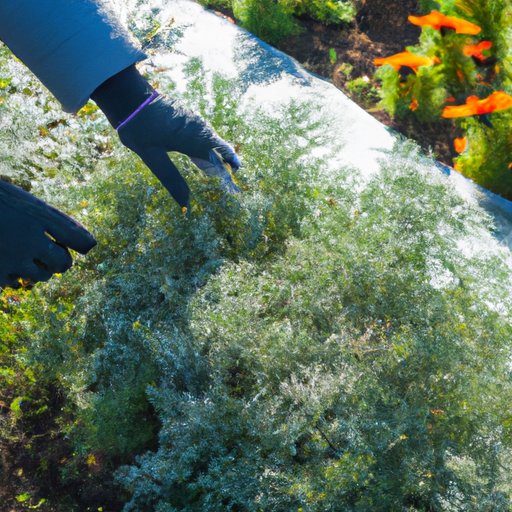
Introduction
Frost damage can wreak havoc on your plants, causing them to wilt and turn brown, and in severe cases, die altogether. The effects of frost can be detrimental to the well-being of many types of plants, so it’s essential to know how to protect them when the temperature drops. In this article, we will outline various strategies for protecting plants from frost damage.
Cover the Plants
One of the most effective ways to protect your plants from frost is to cover them. There are many materials you can use to cover your plants, including burlap sacks, blankets, or tarps. The key is to ensure that the covering material fits tightly around the plant to trap heat.
It’s important to avoid covering plants with plastic, as it can trap moisture and ultimately cause more damage. Instead, use materials that allow for some airflow, such as burlap. Avoid hanging the material directly on the plant’s leaves or branches.
It’s best to cover your plants in the late afternoon or early evening before the temperature drops. This allows the soil to retain as much heat as possible and helps prevent frost from setting in. Be sure to remove the coverings in the morning when the temperature begins to rise, as keeping them covered for too long can lead to overheating and plant damage.
Water the Plants
Ensuring that the soil around your plants is moist is essential in preventing frost damage. Dry soil will cause the plants to freeze faster, leading to damage that can compromise the plant’s overall health.
It’s essential to water your plants at ground level, avoiding getting water on the leaves, as it can freeze and ultimately damage the plant. Water your plants early in the day so that the moisture can soak into the soil before the temperature begins to drop in the evening.
Select the Right Location
If you’re planting new plants that are susceptible to frost damage, it’s essential to choose a location that offers protection from the cold. Consider planting the plants on the side of your home or other structures that can offer protection. Alternatively, bring your plants inside a garage or shed to protect them from the cold.
Of course, not everyone has the luxury of bringing their plants indoors or having the ideal location available. In this case, covering and mulching will likely be your best options.
Use Mulch
As well as insulating soil and protecting against moisture loss, mulching can provide a layer of protection against frost damage to the plant’s roots. It’s essential to avoid over mulching, as this can lead to water retention and over-saturated soil.
The amount of mulch needed can depend on the plant variety, the region in which it is growing, soil type, and other factors. As a general rule, spread 2-3 inches of mulch around the base of your plants, leaving some space around the stem to prevent rot.
Use Frost-Protecting Sprays
Another way to protect your plants from frost damage is to use frost-protecting sprays. These sprays work by creating a thin layer of ice protection around the plant. When applied correctly, they can protect plants down to a temperature of 25°F to 28°F. It’s essential to follow the manufacturer’s instructions when applying frost-protecting sprays to avoid damaging delicate leaves.
Plant Frost-Resistant Varietals
In areas with frequent frost exposure, planting frost-resistant plants is an ideal solution to avoiding plant damage. Frost-resistant plants are those that can withstand mildly freezing temperatures, and in some cases, sub-zero temperatures. Some popular frost-resistant plant varieties include holly, juniper, yew, and others.
Ensure that you’re selecting plants that are ideal for your region and are well-suited to your growing conditions. Remember, while planting frost-resistant plants can protect against frost damage, it’s still important to take precautions, such as mulching and covering, for added protection.
Conclusion
Protecting your plants from frost damage is essential for maintaining their health and longevity. By following the tips outlined in this article, such as covering your plants, watering them correctly, mulching, and selecting frost-resistant varieties, you can help safeguard them from the damaging effects of frost exposure. We encourage you to take proactive steps to study and protect your plants for a long-lasting, healthy garden.




